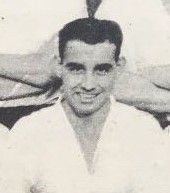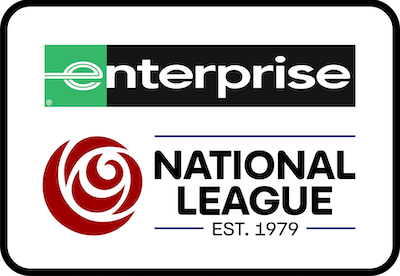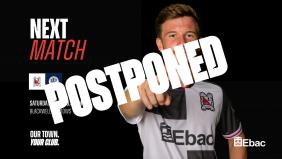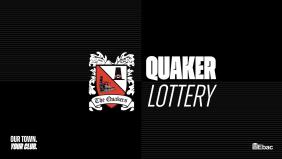Memories of a lifelong fan
Back in 2002, lifelong fan Doug Embleton wrote about the early part of the 1960-61 season when Quakers regularly played in front of five-figure crowds.
Here are his memories from the Farewell to Feethams book.
The four months of September to December in the 1960-61 season are possibly the most eventful ever at Feethams.
The Tin Shed was completed, the first floodlights opened, the West Stand burned down, a crowd record of 21,000 was set at home against Bolton Wanderers, the team surged towards the top of the League; then an epic FA Cup tie against Hull City went to an amazing four midweek replays.
For years, Feethams had been relatively neglected and the cricket field end had simply been a few concrete steps, then a small bank of cinders (to just below the height of the current Tin Shed steps), with occasional wooden barriers along the cinder bank. In the early and latter months of the season fans could turn round and watch the cricket if the football was poor. Rumours of the installation of swivel seats for this purpose were never confirmed. There were no rear barriers... just a sheer drop.
The South Terrace (then called ‘The South Park End'), whilst much larger, was similar. Most people had favourite spots. The paddock in front of the small West Stand was usually full, (It remains the same today, for the insurance policy after the fire insisted on the same design, size and materials).
The corner which now accommodates the Quaker Centre was known as 'Spratt's Corner' because of a large brick wall of a building which carried an advert (white paint on a black background) for “Spratt's Pet Foods". Some of the old sages used to gather by this wall.
Tickets were bought at the Twin Towers and additional small amounts were paid at separate turnstiles for the paddocks. When I became a regular in the mid-50s, junior admission was one shilling and threepence approximately six and a half pence.
In the 1960-61 season, the opening home game against Doncaster drew 7,890, and the first away game at Crystal Palace attracted 21,784.
The Tin Shed was nearing completion and the fascination with it emerged because it was a 'cantilever’ design -- no support posts to block the view. It rapidly became the place where younger Quaker supporters served their apprenticeship.
Before the corrugated sheeting was installed, you could see the cantilever roof supports.
After an indifferent start (including a 5-0 thumping at Hartlepool, but fear not, they went on to finish second bottom), the corner turned with a 4-1 win at Southport.
The floodlights were opened on a Monday evening of torrential rain as 6,168 saw Darlo beat Millwall 5-2. The novelty of evening floodlit games was tremendous, but the event was marred by news the next day. As a result of faulty cabling or a spark, the West Stand had been badly damaged by fire. The next months would be played out, often in front of big crowds with just the empty, burned-out shell of the West Stand.

The team was beginning to balance with the arrival of Ray Spencer, a left sided wing half. Keeper Colin Tinsley had played for Grimsby and was safe if unspectacular, Brian Henderson (nicknamed 'Gento' based upon Real Madrid’s Brazilian winger and in recognition of the surging runs down the wing, which Brian would make whenever the chips were down) formed an uncompromising full- back partnership with George Mulholland. The half back line was a list of Feethams legends; Ken Furphy at right half, Ron Greener at centre half and Spencer at left half.

Joe Rayment was a fast, diminutive right winger, Jim Milner a striker-cum- inside right; Dave Carr a no-nonsense centre forward (who was injured just as the famous 'run' began), Bobby Baxter was the son of a Scottish international and a scheming plus goalscoring inside forward with an educated left foot. Left wing was allocated to Brian Redfearn, father of Neil Redfearn and nicknamed 'Cheyenne' because his huge frame and appearance resembled a TV cowboy character at the time. He was injured and his place went to Keith Morton.

Feethams games in winter kicked off at 2pm and ended in ‘half-light.’ The extra time cup win over Chelsea in 1958 ended almost gin darkness.
So, floodlights, to coincide with the new opportunities in the League Cup, were a big thrill. We had a new strip which paid homage to the fashion for V necks and short sleeves... Darlo’s white shirt carried thick black segments around the ‘V’ and around the end of the short sleeve. There was even a trendy new sock white apart from one thin black line at the top fold.
Results improved, and when Darlo beat Crystal Place then West Ham at Feethams in the League Cup, the lack of stewarding led to logjams of people at the corners of the ground, Somehow, everybody packed in.
Bolton were drawn next and the police set a 21,000 all ticket capacity. In the meantime, Grimsby were beaten at Feethams in front of 12,357. I remember Lance Robson scoring wit ha trick of his by chasing a back pass, then seeming to extend his leg to scoop the ball in.
The Darlo surge was feeling unstoppable. Many of the players lived in club houses, particularly in the Yarm Road area. Rumours abounded on the basis of ‘player x said’ and buses and bus stops were the next best thing to a Darlo website! A favourite quote was “Ken Furphy said that at the moment Darlo are unbeatable.” For a few glorious weeks that was how it seemed.
In November, a Feethams game against Chester was played in fog which would have abandoned any game today. As many fans as possible crowded behind the Chester goal, the ‘Pink’ had to be consulted for the final score (2-1 to Darlington) and my abiding memory is of shadows of players emerging from the foggy backdrop of the West Stand.
November was the month it began to come off the rails, but not before 21,023 crowded into Feethams to see Bolton Wanderers and the famous England internationals Nat Lofthouse (centre forward) and Eddie Hopkinson (goalkeeper) beat us 2-1.
In the second round of the fA Cup against Hull City came a defining moment. With time running and us losing 1-0, Bobby Baxter pumped a speculative shot towards the Tin Shed. The ball went over the bar (I was at the front behind the net, so had a good view) and with the ref walking back to the centre and looking at his watch, one of our group from the old Darlington Grammar School (who will remain nameless) pushed the ball under the net to get the goal kick taken quickly.
As the referee turned, he saw the keeper bending to pick the ball out of the net – and blew for a goal. This quirk of fate set up four replays.
Around the same time, the railway system came into its own and I feel that Darlo should never allow the ‘steam train’ to disappear from its club crest. It is important that a football club retains contact with its roots.
In the 1960, Darlington was the railway town. This is reflected in my memories of the replays. ‘Football Specials’ were efficiently and quickly arranged from Bank Top Station, Indeed, the first replay at Hull was on the Monday following the 1-1 home draw. Diesel trains left the station at teatime. Most travelling fans came directly from work or school. The aroma was a mix of factory grease, thermos flask tea and various bait box sandwiches. The reading material was the Evening Despatch.
Travel was easy in 1960. For the first replay, trains took people directly to the Hull ground then home. A 1-1 draw in front of 18,125.
The second and third replays at Leeds and Doncaster (1-1 and 0-0 respectively) also involved ‘Special Trains’. On arrival, there were long queues of ‘Football Special’ buses outside the station which would take everyone straight to the ground for a few more pence. If you consider that the first two games were played on a Saturday and the following Monday, and that replays three and four were played on a Tuesday (Doncaster) and Thursday (Ayresome Park) it makes a mockery of modern-day complexities. Today’s transport system and all ticket arrangements wouldn’t cope.
By the time the sage reached Ayresome for the fourth replay. Hull made five changes to counteract exhaustion. Against a largely unchanged Quakers, Hull won 3-0 in front of 19,366 fans,
Darlo had by then played eight cup games by mid-December. The squad (only 23 players made first team appearances in the season) was exhausted and then lost 4-0 at Doncaster and 5-1 at table topping new boys Peterborough.
But I remember Hartlepool being mercilessly beaten 4-0 at home on New Year’s Eve.
Sadly, by the end of that memorable season, Darlo finished seventh and crowds were down to 4,000 – 5,000. Nevertheless, as the ‘Spatch’ and the Gazette ‘Pink’ confirmed in those months from September to December, Darlo were near invincible and the memories of the crowds, goals and players will last a lifetime.










-article-list.jpg)



